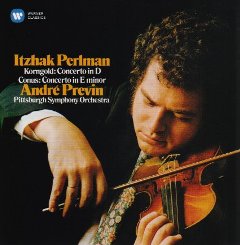Korngold and Conus - Violin Concerto (1981)
Korngold and Conus - Violin Concerto (1981)

Erich Wolfgang Korngold: Violin Concerto In D, Op. 35 1. A1 Moderato Nobile (08:30) 2. A2 Romance (Andante) (08:14) 3. A3 Finale (Allegro Assai Vivace) (07:11) Julius Conus: Violin Concerto In E Minor 4. B1 Allegro Molto - Adagio - Cadenza - Allegro Subito (18:59) Itzhak Perlman – violin Pittsburgh Symphony Orchestra Andre George Previn – conductor
Erich Korngold, the son of an influential music critic, made an early splash as a child prodigy. By the time he was in his thirties, he was a successful opera composer and teacher in Vienna. For all his European triumphs, he is best remembered for his work as a film composer, which began in 1934 when Max Reinhardt, the Austrian director, invited Korngold to Hollywood to adapt Mendelssohn’s music for a new film of A Midsummer Night’s Dream. For four years, Korngold shuttled between Vienna and Hollywood, composing scores for such films as Anthony Adverse (1936) and The Adventures of Robin Hood (1938), which both won Academy Awards for best score. Drawing on his operatic background, Korngold reshaped the art of film scoring by applying the principle of leitmotif, wherein memorable snippets of music accompanied particular characters or ideas.
Korngold was in California when the Nazis annexed and occupied Austria in 1938. From then on he made Hollywood his home, taking American citizenship in 1943. He ceased composing “serious” music for the duration of the war, although he continued to produce film scores. In the spring of 1945, he finally acquiesced to his friend Bronislaw Hubermann, who had been urging Korngold to write him a violin concerto. The work stalled after a young violinist gave a disastrous reading of a draft, leaving Korngold to wonder if the violin part was too difficult; meanwhile, Hubermann balked on scheduling a premiere, hedging until he could see a finished score. The impasse broke when Jascha Heifetz’s manager learned of the situation, and arranged for his star violinist to look over the concerto. Heifetz loved it, and actually encouraged Korngold to make the solo part more virtuosic. Korngold soon finished the work, and Heifetz gave the premiere performance in St. Louis. Heifetz’s many subsequent performances, plus his 1953 recording, helped establish Korngold’s concerto as standard repertoire for violinists. ---content.thespco.org
Conus was a Russian (actually spelled Konius)who lived in Paris and taught at the Russian Conservatoire of Paris. His concerto is written in a "French" style, using chromatic harmony, but keeps the sweep op big Russian Themes alive at the same time.
Technically, it offers great opportunities to develop your coordination, your ear, your sense of rhythmic flow and especially your focused concentration when practicing. Its an excellent piece. The second movement is very beautiful.
The concerto is in an unusual form. Essentially, it is in one movement because the first movement is interrupted in the middle by the second movement, then resumes in in the recapitulation. There is an extensive cadenza followed by a page long coda to conclude. ---David Russel, violinist.com
Erich Korngold, cudowne dziecko z Wiednia, stał się twórcą tzw. „hollywoodzkiego brzmienia”, poprzez swój koncert skrzypcowy, który wykorzystano w wielu ścieżkach dźwiękowych do filmów. Żaden inny solista nie oddaje lepiej emocjonalności tego utworu i jego poruszającej nostalgii, niż Itzhak Perlman. Dzieło Korngolda połączone jest na płycie z niezwykle melodyjnym koncertem rosyjskiego kompozytora – Juliusa Conusa – pochodzącym z 1898 r. Porywający, dowcipny, energetyzujący… o Itzhaku Perlmanie słyszał niemal każdy. Ten legendarny artysta jest bez wątpienia jednym z najwybitniejszych skrzypków naszych czasów. Jego niezwykle bogaty repertuar, obejmuje zarówno „żelazne” pozycje skrzypcowe, jak i rzadko wykonywane dzieła klasyczne, ale też jazz, muzykę klezmerską, a nawet muzykę filmową. Trudno opisać wkład Perlmana w historię wiolinistyki, co więcej fantastyczny charakter, błyskotliwe poczucie humoru i charyzma, czynią zeń fascynującą osobowość o bardzo wyrazistych rysach zarówno z artystycznego, jak i czysto ludzkiego punktu widzenia. ---dalga.pl
download (mp3 @320 kbs):
yandex 4shared mega mediafire zalivalka cloudmailru uplea








